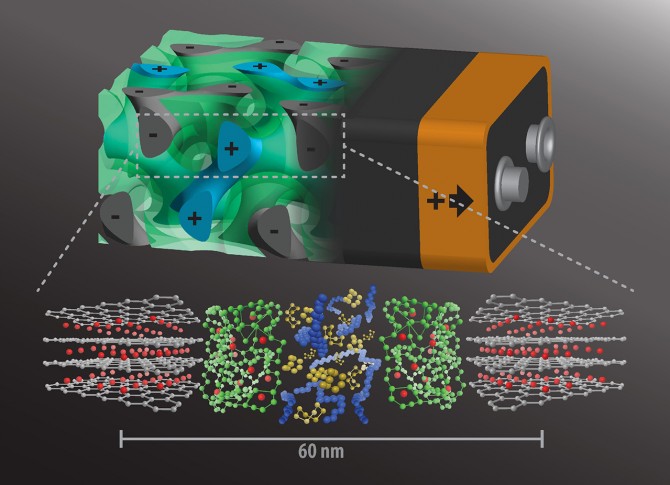By Warren Miller, contributing writer
Researchers at Cornell University have designed a faster-charging, longer-lasting battery that may revolutionize the consumer electronics industry. According to the team, the new battery structure could theoretically charge in seconds.
The concept behind the new design is innovative — unlike typical battery construction, with an anode and a cathode separated by a non-conductive element, this design seeks to eliminate all of the dead space by enmeshing nanoscale pores in a three-dimensional formation. Each pore is approximately 40 nanometers wide and coated with a 10-nanometer-thick layer of insulating, ion-conducting separator. Sulfur is utilized as a cathode material, but because sulfur doesn’t conduct electricity, one final component — an electricity-conducting polymer called poly(3,4-ethylenedioxythiophene) (PEDOT) — is used to top off the pores.

Image source: Cornell.
“This is truly a revolutionary battery architecture,” said Ulrich Weisner, the Spencer T. Olin Professor of Engineering in the Department of Materials Science and Engineering at Columbia. “This three-dimensional architecture basically eliminates all losses from dead volume in your device. More importantly, shrinking the dimensions of these interpenetrated domains down to the nanoscale, as we did, gives you orders-of-magnitude-higher power density. In other words, you can access the energy in much shorter times than what’s usually done with conventional battery architectures.”
On the other hand, the new design does have some potential drawbacks. The PEDOT layer doesn’t expand like the sulfur does, creating tears in the polymer that don’t mend when it shrinks again. This effect causes slow degradation of the battery’s charging capacity, meaning the more times you charge it, the more frequently you’ll have to keep charging it (like almost all batteries in consumer electronic devices).
Still, the reduced charge time alone could mean a windfall for the designers. Consumers wouldn’t mind having to plug in their smartphones or tablets more than once a day if they could unplug them seconds later. Faster-charging batteries are the future of not only consumer electronics but also electric vehicles. The main impediments to the proliferation of electric vehicles are the lack of access to charging stations and the time it takes to recharge the vehicles. If an electric car could reach a full charge in a matter of seconds (or even minutes, allowing for scale), gas-powered vehicles could become a thing of the past in a matter of years.
Advertisement
Learn more about Electronic Products Magazine





